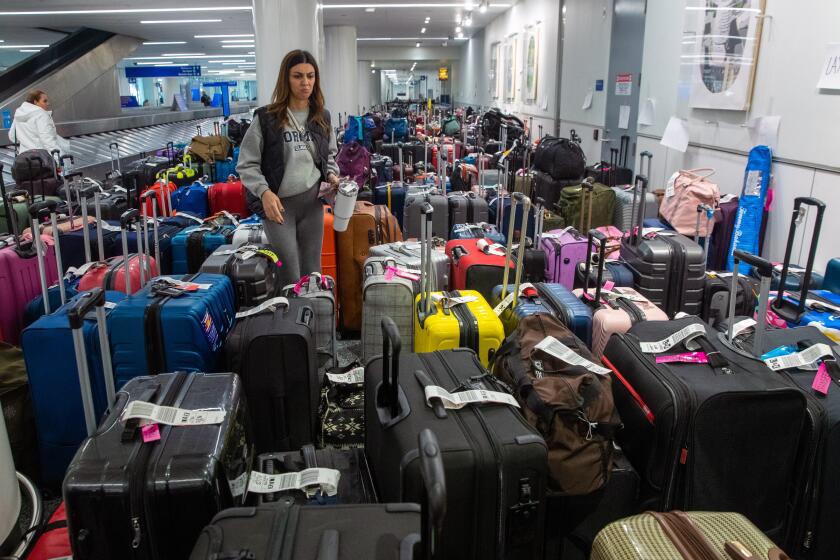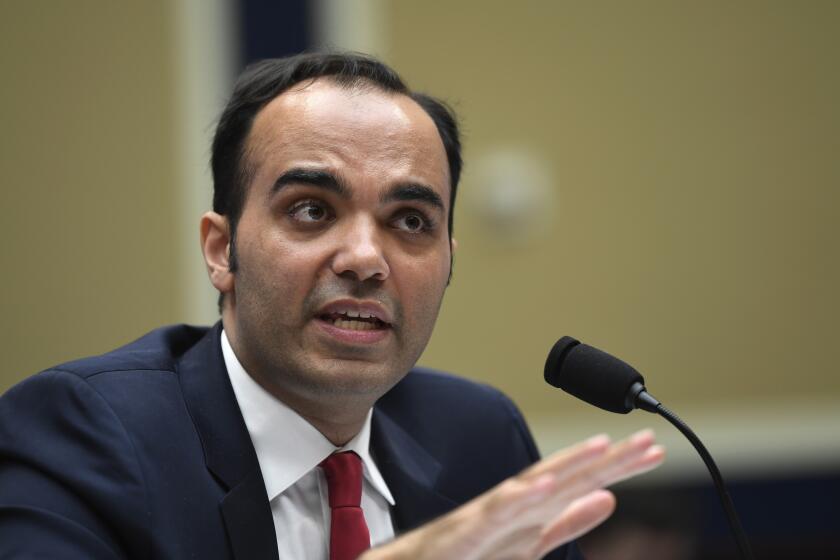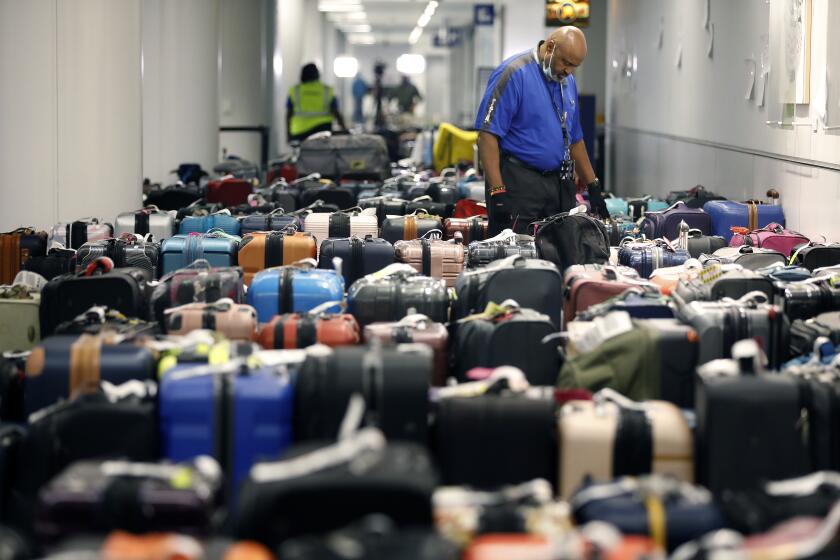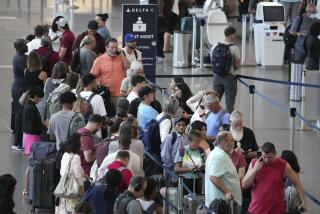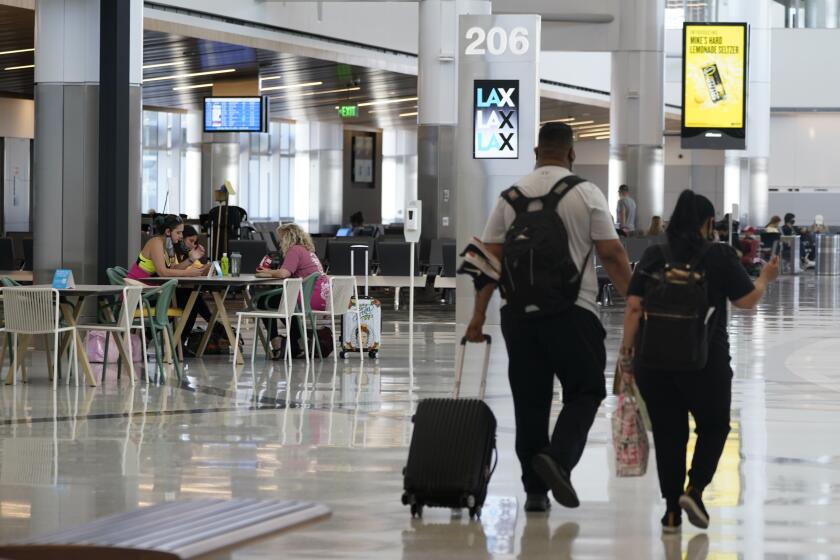Column: The government slams Southwest for its Christmas 2022 meltdown, but is it enough?
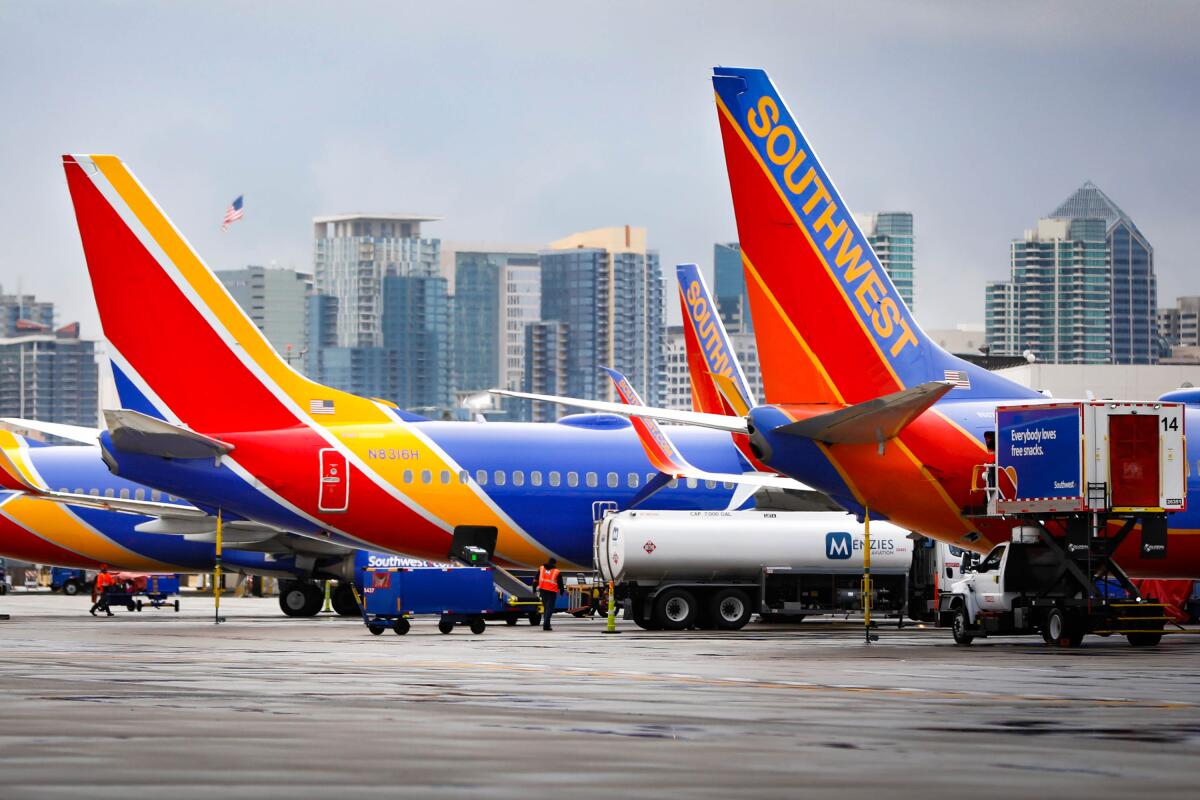
- Share via
For travelers trying to reach their destinations during the storm-tossed holiday season last year, there was no problem identifying the Grinch who stole Christmas: It was Southwest Airlines.
Southwest, it may be recalled, canceled or delayed more than 16,900 flights between Dec. 21 and Jan. 2, stranding more than 2 million passengers. The meltdown kept travelers from their holiday getaways, stuck in airport terminals without hope of prompt rescheduling, and separated untold numbers from their baggage.
It’s not unusual for consumer companies responsible for mass inconvenience to skate on the consequences, announcing their intention to do better next time and paying off a few aggrieved customers with chump change, sometimes through legal settlements in which lawyers collect a large share of the compensation.
Airlines still torment travelers with delays, lack of refunds, lost luggage and involuntary bumping. The DOT and Congress need to do more to protect consumers.
— Teresa Murray, U.S. Public Interest Research Group
Not this time. On Monday, the U.S. Department of Transportation announced that it has slapped Southwest with a $140-million penalty for its breach of fundamental consumer protection rules.
The penalty — which amounts to a negotiated settlement of a DOT complaint, includes a $35-million cash fine and a mandate for at least $90 million in passenger compensation for future scheduling problems — is 30 times larger than any previous DOT penalty, the agency said.
Get the latest from Michael Hiltzik
Commentary on economics and more from a Pulitzer Prize winner.
You may occasionally receive promotional content from the Los Angeles Times.
The previous high-water mark was a $4.5-million penalty assessed against Air Canada in 2021 for failing to fully refund passengers for flights canceled at the outset of the COVID-19 pandemic.
The general cause of the air travel chaos last Christmas was a storm that hammered the heartland and Eastern Seaboard from Dec. 21 to Dec. 26. Cancellations and delays afflicted the entire U.S. air transport system, but most major airlines recovered within days of the onset.
Southwest, however, remained mired in disaster through New Year’s Day. As 2022 drew to a close, the airline still accounted for about 80% of domestic flight cancellations.
As large as the financial penalty is, what may be most striking about the DOT’s order is its recounting of the details of the Southwest fiasco and its effect on consumers.
Passages in the agency’s order have the immediacy and familiarity of a novel drawn from real life, as if the DOT, unusual if not unique among federal agencies, had a direct line into the psyches of air passengers struggling to get through to someone — anyone — at Southwest’s customer service department.
Southwest Airlines, like so many American companies, spent money on dividends and stock buybacks instead of technology and infrastructure.
“Passengers were forced to wait on hold for many hours to connect with a Southwest agent,” the order recounts. “Consumers complained that their calls would suddenly drop after waiting on hold for hours.” Even after getting through, some callers had to wait for hours more to speak to a human representative.
Although U.S. airlines are required to notify passengers and the public of any schedule change within 30 minutes of the change, in this case many customers who had submitted their email addresses or cellphone numbers or could consult the airline’s website received no information or inaccurate or outdated updates. Some consumers told the DOT that they “only found out that their flight had been canceled after driving to the airport.”
Who among us hasn’t had any of this happen to them?
The problems continued when passengers tried to receive refunds for their fares or add-on fees for upgraded boarding, early check-ins or baggage. Although Southwest was required to provide passengers with credit card refunds or transferable travel vouchers, thousands received only nontransferable vouchers. (Southwest eventually replaced these with transferable credits under pressure from the DOT, the agency said.)
Refund requests transmitted through the airline’s website often fell through the cracks, in part because the system rejected requests with minor errors in the confirmation codes they submitted. Also, Southwest recycled confirmation codes and rejected refund requests with the resulting mismatches of names and confirmation codes.
None of that would have had long-lasting consequences, except that Southwest didn’t notify passengers that their refund requests had been rejected, so they weren’t aware they had to resubmit them.
One interesting feature of the DOT order is its observation that by not adequately staffing its customer call center, Southwest caused “substantial harm to consumers” that was “not outweighed by countervailing benefits.”
This can be read as a preemptive strike against any effort by Southwest to claim that its failures were the result of “trying to serve you better,” that all-purpose corporate explanation for layoffs and cutbacks in customer service departments.
A proposed model law could rein in some of corporate America’s bad behavior toward consumers.
The practice of cheaping out on customer service staffing “appears to benefit only the carrier in reduced staffing and IT [information technology] costs at the expense of consumers,” the DOT said, calling this “deceptive” because Southwest promised but failed to deliver effective customer service.
Consumers, the DOT said, “do not expect to face unreasonably long wait times, busy signals, and/or disconnected calls when attempting to reach airline customer service agents” during flight disruptions.
Whether the DOT’s punishment of Southwest will do much to improve the plight of U.S. air travelers is up for debate. Some consumer advocates don’t think so.
“Southwest wasn’t the only airline to fail travelers last holiday season,” says Teresa Murray of the U.S. Public Interest Research Group. “While cancellations are down over last year, airlines still torment travelers with delays, lack of refunds, lost luggage and involuntary bumping. The DOT and Congress need to do more to protect consumers.”
Southwest executives have issued public apologies and its front-line workers have taken the brunt of customer fury, but the board of directors is missing in action
The Southwest penalty may not be as harsh as it could have been. In gross numbers, $140 million is a sizable financial hit for a company that recorded $539 million in profit on $21.4 billion in revenue last year and $717 million in profit on $17.4 billion in revenue in the first nine months of 2023.
But it didn’t shake Southwest’s intention to pay shareholders quarterly dividends of 18 cents per share, or $107 million per quarter; the company also is sitting on an unspent authorization for about $900 million in stock buybacks, another handout to shareholders.
Nor does the penalty translate into $140 million in cash upfront. The $35-million cash fine can be paid in three annual installments through 2026, and $72 million of the penalty can be paid off via customer vouchers at the rate of at least $30 million a year through April 2027.
The vouchers, for future travel on Southwest, have to be worth at least $75 each and be fully transferable, though they can expire one year after issuance. They’re to be issued for cancellations or delays of three hours or more that result from issues under Southwest’s control — one can foresee quibbling over whether a delay is Southwest’s fault or an act of God.
Indeed, in reaching the settlement, Southwest didn’t admit any violation of federal law or DOT regulations or concede the agency’s findings. The airline maintains that it did all that was humanly possible to serve customers during an “unprecedented winter storm” and pleads in its response to the DOT order that “no process is perfect.”
Baggage fees, drug prices, net neutrality — Biden aims to reduce industry’s control of your daily life.
The airline has also issued about $600 million in refunds, reimbursements and other customer blandishments such as loyalty program miles, though much of that expense was due to pressure from the DOT or an effort by Southwest management in the wake of the meltdown to keep its name from being mud.
All this still leaves open the question of what is likely to change at Southwest or, for that matter, at other major airlines.
One remedy that might really have worked to change the culture at Southwest isn’t part of the government order, and perhaps could not be: cleaning house at the top. Of Southwest’s 12 current non-management directors, all but three were in place during the 2022 debacle and five were on the board during the airline’s previous customer-service catastrophe, in 2014.
The ability of corporate directors to hang on to their seats as if with prehensile behinds (to filch Orwell’s turn of phrase) underscores the uselessness of corporate boards.
These are people who almost never pay a price for the corporate disasters occurring on their watch. Instead, they continue to snarf up lavish compensation as figureheads.
Southwest’s 11 outside board members (not including the company’s current and former chief executives or the directors elected this year) received average compensation of nearly $300,000 each in cash and stock grants last year.
The 2014 and 2022 meltdowns were both the product of issues that were no secret in the corporate suite or the boardroom. These included Southwest’s quick turnaround, just-in-time, low-overhead operational culture and the inadequacy of its technological systems to manage if the schedule blew out at any seam. They weren’t sufficiently fixed after 2014.
The company says it moved full speed ahead this year to ensure that future Christmases won’t look like last Christmas, but we may not know until the next yuletide snowstorm.
The DOT under Transportation Secretary Pete Buttigieg has asked Congress for higher statutory penalties, more latitude in imposing them, and tighter mandates for passenger refunds and reimbursements.
We’re still waiting. We know that winter storms will always be with us. Let’s just hope that it won’t take another $140 million in penalties to force the airlines to be better prepared when they happen.
More to Read
Get the latest from Michael Hiltzik
Commentary on economics and more from a Pulitzer Prize winner.
You may occasionally receive promotional content from the Los Angeles Times.

